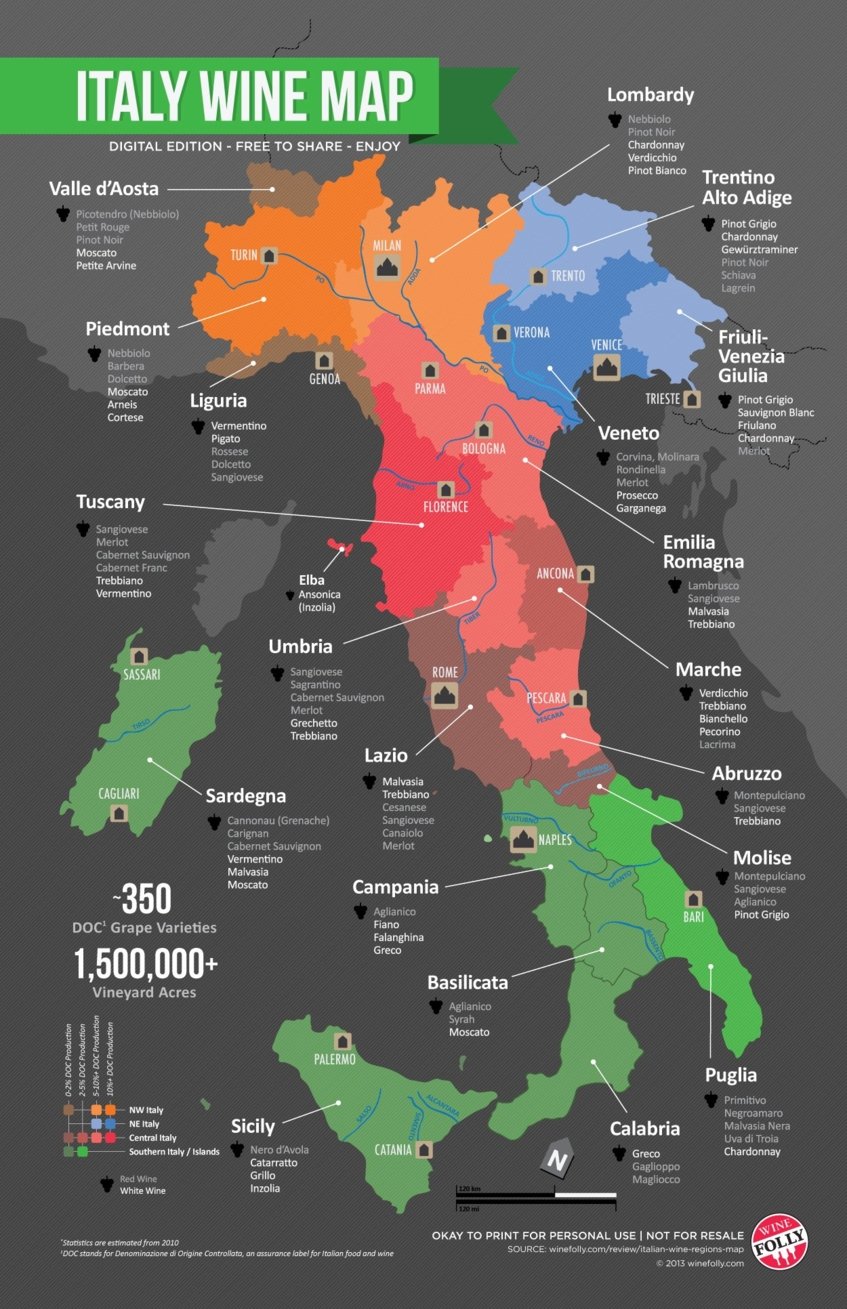Taking a look at the wine map of Italy reveals 332 DOCs (denominazione di origine controllata) and 73 DOCGs (denominazione di origine controllata e garantita), not to mention all the IGTs (indicazione geografica tipica) that you’ll find scattered across the 20 regions on a map of Italian wine regions.
A wine regions of Italy map will reveal wine-growing areas throughout the country. From the far north in Alto Adige and Vall d’Aosta, up in the shadow of the Alps, right down to the far south, with islands, such as Pantelleria, a stone’s throw away from Africa, also producing wine, every region in the country features on its wine map. Italy’s long boot-shaped peninsula is familiar to most people and its long coastlines mean that wine-growing areas close to the sea are tempered by cooling sea breezes, yet Italy is also a mountainous country with the Alps and Dolomites in the north and the Apennines forming the backbone of the country, with Etna in Sicily rising to 3,350m. A glance at an Italy wine regions map shows that most successful wine regions are located on hillsides, such as Barolo, Chianti, Soave and Prosecco, and at altitude, like Etna and Valtellina. Bulk wine production, such as that of the Veneto, generally finds its home on the plains, traditionally given over to wheat and vegetable production.
As the climate is also affected by elevation, a region that is further south on the wine map of Italy is not necessarily hotter. In northern Alto Adige, narrow, heat-trapping Alpine valleys allow Cabernet Sauvignon to ripen, Tuscany is generally hotter than Umbria although it is further north, northern Piedmont is mainly a producer of powerful red wines, whereas central Italy is more famous for its whites than reds and Sicily, the southernmost region on the Italy wine map produces more white than red, and Trapani in the far southwest of the island produces almost exclusively white wine for its fortified Marsala. Italy’s landscape is capable of turning your expectations on its head.
No less confusing is the varietal map of Italy; wine regions are also populated by a startlingly large range of indigenous varieties, most likely running into the thousands, although 350 are currently recognized and authorized. Sangiovese, Montepulciano and Trebbiano rub shoulders with international varieties such as Merlot and Chardonnay. To make matters worse, many grapes have different names – Nero d’Avola is also known as Calabrese, Sangiovese is known under a variety of names including Brunello, Morellino and Prugnolo Gentile in Montepulciano, where it produces Vino Nobile di Montepulciano. And, you of course shouldn’t confuse this with the grape variety Montepulciano, which produces Montepulciano d’Abruzzo. There are numerous groups of grapes with the same name, such as Malvasia, Moscato, Trebbiano, Greco and Vernaccia; some are related and some are not.
Although there are some key DOCGs sought after by wine lovers around the globe, such as Barolo, Barbaresco and Brunello di Montalcino, and other well-recognized wines like Amarone della Valpolicella, Prosecco, Chianti, Soave and Franciacorta, there are plenty of new wines from the center and the south gaining in popularity – Primitivo, Nero d’Avola and Verdicchio to name just a few. Nearly all of Italy’s wine regions hide some little-known varieties, just waiting to be discovered, and a new wave of winemakers keen to discover this wealth of local varieties is now emerging.
At Wine Paths, our team of local experts can help you navigate the intricacies of the wine map of Italy.
If you're interested in one of our Italy Wine Tours, please visit this link.








